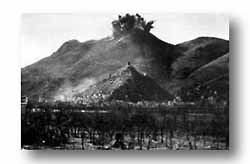| The Allies had procrastinated too long. The fact
remained that the Germans were using high ground in vicinity of the 1,400 year-old
Benedictine Abbey on Montecassino as artillery observation posts. Because of them,
American men died daily. "If we
have to choose between destroying a famous building and sacrificing our own men, then our
men's lives count infinitely more, and the buildings must go," decreed General
Eisenhower.
|
|

The first of the heavy bombs brought by the Flying Fortresses
strikes the abbey on Montecassino Hill. |
| In mid-February 226 Fortresses,
Liberators, Mitchells, the Marauders flew over the snow-capped mountains, and with
terrifying precision dropped their bombs on the monastery. From neighboring Castellone
Ridge men of the 36th watched excitedly as the great billows of smoke and flame consumed
the abbey. By the next day only one
small section remained standing. But even after the bombing, Allied offensive attacks
fared no better.
|